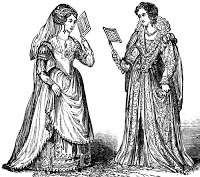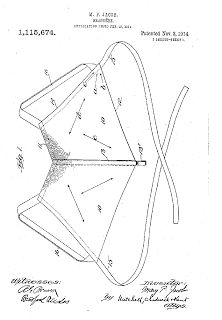Discerning the true history of the bra has taken longer than expected as there is quite a bit of conflicting information on who wore bra-like instruments, starting when, and how they evolved into today’s modern bra. One of the interesting facts that I was able to uncover is that there is no evidence that women in the 1960s ever actually burned bras in protest. It appears to be a myth, but I’ll get to that in order.

It is widely believed that Minoan Civilization living on the island of Crete from roughly 2700 BC – 1500 BC were the first to wear breast-enhancing garments. Note that these weren’t actually bras as the breasts were generally left uncovered as depicted in this Minoan snake goddess image on the left. However, the garment lifted the breasts giving them both form and support.
In both Ancient Egypt and Ancient Greece, women’s breasts went mostly uncovered. The ancient Greeks did have a type of bustier called an apodesme which consisted of thin wool or linen ribbons. Some sources say it tied under the bust for support while leaving the breasts bare, while others claim it tied around the bust but was only used for sport to provide support.

By 300 AD, the Roman Empire was using a type of bikini for breast support in sports. The “bikini girls” mosaic found in the Villa Romana Del Casale in Sicily depicts women in garments that look very much like modern day bikinis engaged in everything from weight lifting to discus throwing and ball games.
Sources on Roman women’s clothing also mention the Fascia, a bra-type garment that was tightly tied around a woman’s breasts. Some authors state the garment was actually used on younger women specifically to restrict breast growth, but I was unable to find corroborating evidence in historical references. In the 13th and 14th centuries, breasts were being de-emphasized as much as possible. The first corset-like garments had come on the scene, but were meant to flatten and minimize the breasts. An edict of Strasbourg dated 1370 states “no woman will support the bust by the disposition of a blouse or by tightened dress.”

The Renaissance Era brought about a breast enhancement revival with the development of the corset, which cinched the waist and pushed the breasts up to increase the cleavage. Corsets were made with flexible material such as leather or cloth and then stiffened with boning. The boning could be made from whale bones, reeds, wood, steel or even ivory. Modern corsets are still made for Renaissance Faires today and usually have plastic boning.

World War I marked the end of the corset era. Women started working in factories for the first time, and corsets could be cumbersome and dangerous. Both the US and Britain discouraged women from buying corsets with steel boning, as the metal was needed for the war effort. Several reports claim that in 1917 the corset boycott saved 28,000 tons of steel – enough for 2 battleships.

The first American brassiere patent was issued in 1914 to Mary Phelps Jacob, who had sewn together two silk handkerchiefs with some ribbon to create something she could wear with her evening gowns that was more comfortable and would not show.
It was labeled the Backless Brassiere. There is an earlier patent from 1859 on a prototype bra made by Henry Lesher of New York. However, his invention had inflatable pads and was actually designed to help women who had uneven breasts look more symmetrically round. It was also designed to soak up perspiration. So it wasn’t a support or enhancement garment per se.
During the 1920’s women were wearing bandeau-style bras that held the breasts in and down causing the boyish silhouette associated with the Flappers. However, Ida Kaganovich, founder of Maidenform, felt this flattened look was going against nature. She is credited as the designer of today’s modern bra, including the modern sizing method broken into band and cup measurements that are still used today.
In 1928 Ida’s Maiden Form dress shop sold 500,000 bras that were designed to separate and support the breasts. Within a decade, Maiden Form bras were sold in department stores worldwide. Up until 1997, the Maidenform brand remained a family own business. They had an IPO in 2005, but were subsequently bought out by Hanes brands. Unfortunately, Maidenform doesn’t currently make any organic cotton or sustainable bras.
There is a charming report from 1942, during the second World War, in the diaries of Hermione Llewellyn whereby Hermione claimed in front of the Duke of Gloucester that the war-induced rubber shortage would be worse for woman than men because rubber was so widely used in women’s undergarments. A month and half later, she received a package from the Duke. According to her diary, “A magnificent parcel, covered in tape and seals, arrived for me from India. Inside were two pairs of old-fashioned corsets with bones and laces. They were sent by HRH The Duke of Gloucester. Nick and I had an argument as to how one should thank one of the Royal Family for a present of corsets. Whichever way we put it looked disrespectful. Finally, we sent a telegram saying: ‘Reinforcements received. Positions now held. Most grateful thanks.’” (Thanks to Grace from Newport who sent me this lovely story.)
In 1947, Frederick Mellinger of Hollywood invented the first push-up bra dubbed The Rising Star. By 1964, Louise Poirier of Canada had develop a deeply plunged, laced push-up bra dubbed the Wonderbra Model 1300 that largely resembles current designs.

There is some belief that bra sales and development stalled in the 1960s and 1970s due to the bra-burning protests of the feminist era. However, according to Snopes.com, there is no evidence of actual bra burnings. In 1968 feminists protested the Miss America Pageant by throwing items of their oppression into a “freedom trash can.” Among these items of oppression were girdles, high-heeled shoes, some bras, copies of Playboy magazine, and hair curlers. However, the items were thrown out, not burned.
In 1977 Hinda Miller and Lisa Lindahl created the first sports bra by sewing 2 jock straps together and calling it a Jogbra. In the1990’s two profound influences on bras emerged. Madonna wore her cone bras out in public, and is credited with changing the public perception of undergarments. More importantly, several manufacturers, including Blue Canoe, started making bras and underwear out of organically grown cotton without modern chemical finishing agents.

Today our bra options are nearly endless and happily, more and more manufacturers are getting on board with producing sustainable bras. The padded, push-up bra of the late twentieth century is now available made from breathable and soft organic cotton with low impact dyes.
Want to know more about the bras history? If you’ve got $28.95 burning a hole in your pocket (and you’ve already purchased all of the organic bras you need from FaeriesDance.com), you might consider the comprehensive history book, Bra: Webster’s Timeline History, 789 – 2007. At 194 pages long, you should get a bit more detail.

Gabi
Awesome post. I was looking for the history of Bras and you did it 😉
TheBraRecyclers
What a great post about the history of the bra!! We loved it.. Did you know the 2nd Annual Bra Recycling Month is just around the corner. Last year, Bra Recycling Month brought awareness to Breast Cancer and Domestic Violence Awareness by offering women nationwide a chance to provide support for these causes in a unique way, while directly helping to re-shape a life. By recycling new and used bras to women in need in honor of breast cancer and domestic violence awareness, women and girls nationwide also brought attention to another cause, bra recycling.
Bra Recycling is an economical and environmentally friendly way to give support to women nationwide that are breast cancer survivors or transitioning from domestic violence situations.
Bra Recycling Month 2010 concluded with over 7000 bras recycled. This year, our goal is 10,000 bras recycled between October 1 and October 31.
When you recycle your bras during Bra Recycling Month, we will reward you for your generosity by entering you into our prize raffle. For the 2nd Annual Bra Recycling Month, we have partnered with a number of businesses, including Sheila with Cookie Lee Jewelry, Jenneration Fix Inc., and Bra Tree, to provide you with great prizes. Clean out your drawers and help make this year’s Bra Recycling Month even better than last year!